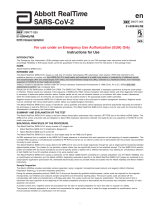
Solana SARS-CoV-2 Assay Page 6 of 13
The external negative control may be treated as a patient specimen. The control should be sampled and tested as if it
were a patient specimen and processed as described above in the Assay Procedure. The external negative control is
used to detect reagent or environmental contamination (or carry-over) by SARS-CoV-2 RNA or amplicon.
It is recommended that the reactivity of each new lot and each new shipment of the Solana SARS-CoV-2 Assay be verified
on receipt and before use. External control tests should be performed thereafter in accordance with appropriate federal,
state and local guidelines. The Solana SARS-CoV-2 Assay should not be used in patient testing if the controls do not
produce the correct results.
LIMITATIONS
Negative results do not preclude infection with SARS-CoV-2 and should not be the sole basis of a patient treatment
decision.
The performance of this test was assessed using nasal and nasopharyngeal swab specimens in viral transport
medium.
Improper collection, storage or transport of specimens may lead to false negative results.
Inhibitors present in the sample and/or errors in following the assay procedure may lead to false negative results.
A trained health care professional should interpret assay results in conjunction with the patient’s medical history,
clinical signs and symptoms, and the results of other diagnostic tests.
Analyte targets (viral sequences) may persist in vivo, independent of virus viability. Detection of analyte target(s)
does not imply that the corresponding virus(es) are infectious or that they are the causative agents for clinical
symptoms.
There is a risk of false positive values resulting from cross-contamination by target organisms, their nucleic acids or
amplified product, or from non-specific signals in the assay.
Based on the in-silico analysis, SARS-CoV and other SARS-like coronaviruses in the same subgenus (Sarbecovirus) as
SARS-CoV-2 may cross-react with the Solana SARS-CoV-2 Assay. SARS-CoV is not known to be currently circulating in
the human population, therefore is highly unlikely to be present in patient specimens.
There is a risk of false negative values due to the presence of sequence variants in the viral targets of the assay.
CONDITIONS OF AUTHORIZATION FOR THE LABORATORY AND PATIENT CARE SETTINGS
The Solana SARS-CoV-2 Assay Letter of Authorization, along with the authorized Fact Sheet for Healthcare Providers, the
authorized Fact Sheet for Patients, and authorized labeling are available on the FDA website:
https://www.fda.gov/medical-devices/coronavirus-disease-2019-covid-19-emergency-use-authorizations-medical-
devices/vitro-diagnostics-euas.
However, to assist clinical laboratories using the Solana SARS-CoV-2 Assay, the relevant Conditions of Authorization are
listed below:
Authorized laboratories1 using the Solana SARS-CoV-2 Assay will include with test result reports, all authorized Fact
Sheets. Under exigent circumstances, other appropriate methods for disseminating these Fact Sheets may be used,
which may include mass media.
Authorized laboratories using the Solana SARS-CoV-2 Assay will use the Solana SARS-CoV-2 Assay as outlined in the
“Solana SARS-CoV-2 Assay” Instructions for Use. Deviations from the authorized procedures, including the authorized
instruments, authorized clinical specimen types, authorized control materials, authorized other ancillary reagents and
authorized materials required to use the Solana SARS-CoV-2 Assay are not permitted.
Authorized laboratories that receive the Solana SARS-CoV-2 Assay will notify the relevant public health authorities of
their intent to run the Solana SARS-CoV-2 Assay prior to initiating testing.
Authorized laboratories using the Solana SARS-CoV-2 Assay will have a process in place for reporting test results to
healthcare providers and relevant public health authorities, as appropriate.
Authorized laboratories will collect information on the performance of the Solana SARS-CoV-2 Assay and report to
DMD/OHT7-OIR/OPEQ/CDRH (via email: CDRH-EUA-Reporting@fda.hhs.gov) and Quidel (via email:
QDL.COV2.test.event.report@quidel.com, or via phone by contacting Quidel Customer Support Services at
800.874.1517 (in the U.S.) or 858.552.1100) any suspected occurrence of false positive or false negative results and
significant deviations from the established performance characteristics of the Solana SARS-CoV-2 Assay of which they
become aware.















